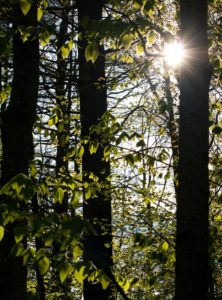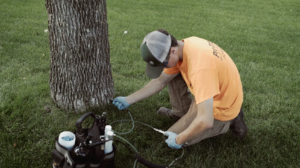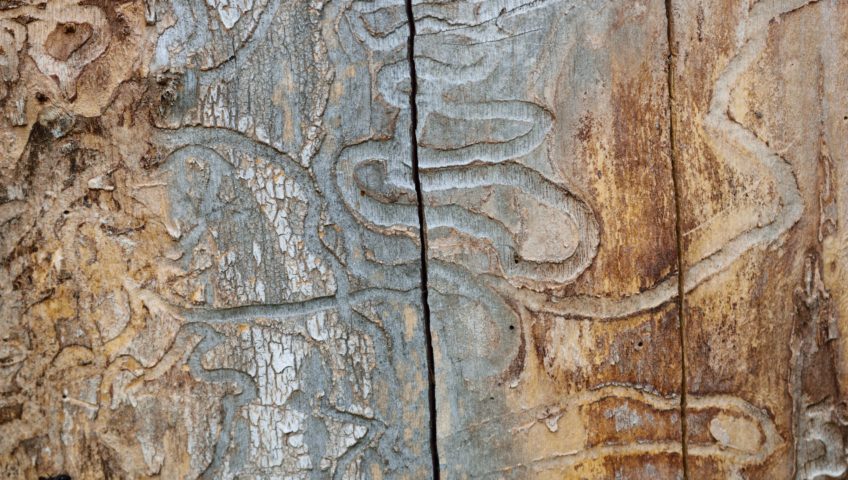Minnesota has a large reputation for being a rugged, northern state filled with thousands of lakes and millions of trees. Especially in residential areas, trees provide important habitats for various animals, produce oxygen for the environment and provide shade during the hot summer days.
In particular, ash trees are very popular throughout the greater Minnesota area, but they are currently threatened due to a damaging invasive insect: the Emerald ash borer.
Emerald Ash Borers In Minnesota
First identified in Minnesota in 2009, the emerald ash borer (EAB) originates from Asia and made its first appearance in the US in 2002. Ever since it arrived, the emerald ash borer has been causing destruction to ash trees everywhere.
After the female EAB lays its eggs on the outside of the ash tree, the larvae hatch and bury themselves inside the tree. As the EAB larvae live and grow underneath the bark, they create S-shaped tunnels up and down the sides of the ash tree as they travel and feed. This damage to the tree disrupts the nutrient flow to the tree’s upper canopy.
Once the Emerald ash borers fully mature, they leave the tree by boring small holes through the tree bark. These holes are now perfect areas for woodpeckers to begin breaking into along with other insects to enter through. As time goes on, the ash tree will progress in showing signs of sickness by its upper canopy beginning to die along with bark splitting. The lifespan for trees affected by EAB’s vary depends on their age as young trees only lasting 1-2 more years, while older and less infested trees may last 3-4 more years.
Since emerald ash borers were first discovered in St. Paul in 2009, these tree-destroying insects have rapidly spread throughout Minnesota. The entire Twin Cities metro area and most of Southern Minnesota is now infested by EAB. As of 2015, emerald ash borers have also spread to the Duluth area. Fortunately, there are many parts of Northern and Western Minnesota where emerald ash borers have not yet been discovered but unless these invasive pests are effectively quarantined, it’s only a matter of time before they spread throughout our entire state.
Signs of EAB Infestation in Your Ash Trees
To combat the threat of emerald ash borers in the Twin Cities metro, it’s important to be able to spot the signs of an infestation in your ash trees as soon as possible. Once EAB larvae begin tunneling their way beneath the bark of your ash tree, the tree will quickly decline and signs will begin to appear one by one. The first sign of emerald ash borers will often be woodpeckers flocking to the infested tree to feed on the larvae. As woodpeckers peck away at the ash tree, the tree will be “blonded” as the outer layer of bark will be stripped off to reveal the lighter bark beneath.
As the EAB infestation progresses, you’ll begin to see visible signs of stress in the dying ash tree. The crown of the tree will thin out, since the damage caused by emerald ash borer larvae prevents key nutrients from reaching the top of the tree and sustaining foliage. Bark will also begin cracking and falling off along the tree, a process worsened by hungry woodpeckers. Finally, as the adult emerald ash borers emerge from the ash tree, you may begin to see exit holes in the bark. These holes are D-shaped and about ⅛ in diameter.
Neighborhood Tree Issues

As many of the largest trees in our urban neighborhoods continue to become infected by the Emerald ash borer, Dutch elm disease, or affected by compacted soils, there are large residential areas losing much needed shade. Through the active management and preventative care of these areas, the beauty of the large shade trees at your home can be preserved for future generations!
These tree management services are also used at the Minnesota State Fairgrounds. Did you know…
- The Minnesota State Fair spends about $40,000 biannually to treat its ash trees to prevent death from emerald ash borer. The treatment program prevents the removal and replacement of the trees which are estimated to cost over $500,000. Learn the value of your individual trees here!
- Home to six American elm trees with diameters close to 4 feet, the Minnesota State Fairgrounds has implemented a treatment program to prevent Dutch Elm disease from killing them.
- You can pick up free tree seedlings each year at the Minnesota Forestry Industries booth in the Education building. Since 1992, the booth has given out a half million free tree seedlings!
Preventing Emerald Ash Borer Infestation
With Emerald ash borers being so prevalent in Minnesota, it’s important to protect ash trees from becoming infested. The best method of treating your ash trees to prevent Emerald ash borer infestation is via trunk injection.

This treatment method involves injecting a chemical insecticide (emamectin benzoate) into the trunk of the ash tree. To complete this treatment process, a certified arborist will drill small holes into the base of the tree in order to place the arbor plug into the holes and inject the insecticide. This treatment will be effective for 2-3 years as it will kill any Emerald ash borers which feed on the ash tree’s leaves and kill nearly all of the EAB larvae inside the ash tree.
If your tree is already affected by EAB larvae, there will be no other treatment to save the tree than to remove it entirely. Cutting down the tree prevents the EAB larvae within the tree from maturing and spreading to the surrounding trees. Make sure to remove the tree before the it has fully died as it will be a less expensive job to complete. Waiting until the tree is dead will be more dangerous for the tree care company to address because of the rotting and fragile tree branches.
Replacing Ash Trees on Your Twin Cities Property
Once your EAB infested ash trees have been removed, you’re left with a decision to make: what do I plant to replace them? Fortunately, there are many trees of comparable size that thrive in the temperate climate of the Twin Cities metro. Make sure to choose a tree that will fit well on the property where you’re planting it, and that is well adapted to the climate and soil conditions of your area.
Some choices recommended by our arborists are:
- River birches, which have papery white bark that give them year-round visual interest and are well-adapted to Minnesota’s climate
- Silver maples, Minnesota native trees that are fast-growing and provide excellent shade for your yard
- Swamp white oaks, which can handle a wide range of temperature and soil conditions as well as being resistant to oak wilt
- Hackberries, particularly hardy trees that are native to Minnesota and can survive both extreme temperature change and strenuous urban growing environments
Reliable Emerald Ash Borer Treatments in the Twin Cities
If you’re needing to protect your ash trees from the invasive Emerald ash borer, it’s time to call a trusted certified arborist. If you’re currently located in the greater Twin Cities area, contact Pro-Tree Outdoor Services. Our professional tree care experts will apply EAB treatments to all of your ash trees in a timely fashion.

